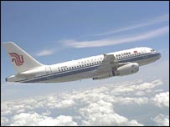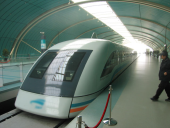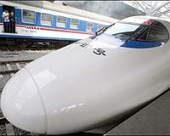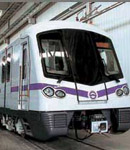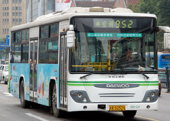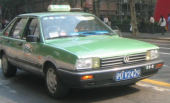
Conference Location
 Shanghai (Chinese: 上海) is the largest city in China, and one of the largest metropolitan areas in the world, with over 20 million people. Located on China's central eastern coast at the mouth of the Yangtze River, the city is administered as a municipality of the People's Republic of China with province-level status.The city is a tourist destination renowned for its historical landmarks such as the Bund and City God Temple, its modern and ever-expanding Pudong skyline including the Oriental Pearl Tower, and its new reputation as a cosmopolitan center of culture and design. Today, Shanghai is the largest center of commerce and finance in mainland China, and has been described as the "showpiece" of the world's fastest-growing major economy.
Shanghai (Chinese: 上海) is the largest city in China, and one of the largest metropolitan areas in the world, with over 20 million people. Located on China's central eastern coast at the mouth of the Yangtze River, the city is administered as a municipality of the People's Republic of China with province-level status.The city is a tourist destination renowned for its historical landmarks such as the Bund and City God Temple, its modern and ever-expanding Pudong skyline including the Oriental Pearl Tower, and its new reputation as a cosmopolitan center of culture and design. Today, Shanghai is the largest center of commerce and finance in mainland China, and has been described as the "showpiece" of the world's fastest-growing major economy.
History
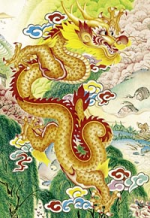
|
During the Song Dynasty (AD 960–1279) Shanghai was upgraded in status from a village (cun) to a market town (zhen) in 1074, and in 1172 a second sea wall was built to stabilize the ocean coastline, supplementing an earlier dike. From the Yuan Dynasty in 1292 until Shanghai officially became a city for the first time in 1297, the area was designated merely as a county (xian) administered by the Songjiang (松江) Prefecture (Songjiang Fu). |
|
Two important events helped promote Shanghai's development in the Ming Dynasty. A city wall was built for the first time during in 1554, in order to protect the town from raids by Wokou (Japanese pirates). It measured 10 meters high and 5 kilometers in circumference. During the Wanli reign (1573-1620), Shanghai received an important psychological boost from the erection of a City God Temple (Cheng Huang Miao) in 1602. This honor was usually reserved for places with the status of a city, such as a prefectural capital (fu), and was not normally given to a mere county town (zhen) like Shanghai. The honor was probably a reflection of the town's economic importance, as opposed to its low political status. |
|
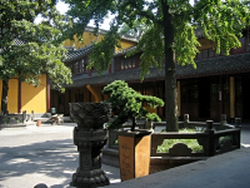
|
During the Qing Dynasty, Shanghai became the most important sea port in the whole Yangtze Delta region. This was a result of two important central government policy changes. First of all, Emperor Kangxi (1662-1723) in 1684 reversed the previous Ming Dynasty prohibition on ocean going vessels, a ban that had been in force since 1525. Secondly, Emperor Yongzheng in 1732 moved the customs office (hai guan) for Jiangsu province from the prefectural capital of Songjiang city to Shanghai, and gave Shanghai exclusive control over customs collections for the foreign trade of all Jiangsu province. As a result of these two critical decisions, by 1735 Shanghai had become the major trade port for all of the lower Yangzi River region, despite still being at the lowest administrative level in the political hierarchy. |
|
The importance of Shanghai grew radically in the 19th century, as the city's strategic position at the mouth of the Yangtze River made it an ideal location for trade with the West. During the First Opium War in the early 19th century, British forces temporarily held Shanghai. The war ended with the 1842 Treaty of Nanjing, which saw the treaty ports, Shanghai included, opened for international trade. The Treaty of the Bogue signed in 1843, and the Sino-American Treaty of Wangsia signed in 1844 together saw foreign nations achieve extraterritoriality on Chinese soil, the start of the foreign concessions. |
|
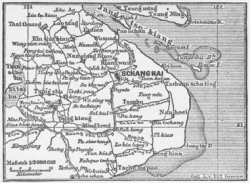
|
1854 saw the first meeting of the Shanghai Municipal Council, created in order to manage the foreign settlements.In 1860-1862, civil war had been two times invaded Shanghai(Battle of Shanghai (1861)). In 1863, the British settlement, located to the south of Suzhou creek (Huangpu district), and the American settlement, to the north of Suzhou creek (Hongkou district), joined in order to form the International Settlement. The French opted out of the Shanghai Municipal Council, and maintained its own French Concession, located to the south of the International Settlement, which still exists today as a popular attraction. Citizens of many countries and all continents came to Shanghai to live and work during the ensuing decades; those who stayed for long periods — some for generations — called themselves "Shanghailanders". |
|
In the 1920s and 1930s, almost 20,000 so-called White Russians and Russian Jews fled the newly-established Soviet Union and took up residence in Shanghai. These Shanghai Russians constituted the second-largest foreign community. By 1932, Shanghai had become the world's fifth largest city, home to 70,000 foreigners. The Sino-Japanese War concluded with the Treaty of Shimonoseki, which saw Japan emerge as an additional foreign power in Shanghai. Japan built the first factories in Shanghai, which were soon copied by other foreign powers to effect the emergence of Shanghai industry. Shanghai was then the most important financial center in the Far East. Under the Republic of China (1911-1949), Shanghai's political status was finally raised to that of a municipality on July 14, 1927. |
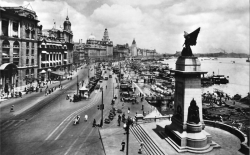
|
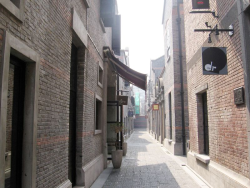
|
The Imperial Japanese Navy Air Service bombed Shanghai on 28 January 1932, nominally in an effort to crush down Chinese student protests of the Manchurian Incident and the subsequent Japanese occupation of northeast China. The Chinese fought back in what was known as the January 28 Incident. The two sides fought to a standstill and a ceasefire was brokered in May. The Battle of Shanghai in 1937 resulted in the occupation of the Chinese administered parts of Shanghai outside of the International Settlement and the French Concession. The International Settlement was occupied by the Japanese on 8 December 1941 and remained occupied until Japan's surrender in 1945. |
|
On 27 May 1949, the Communist Party of China controlled the People's Liberation Army and took control of Shanghai, which was one of only three former Republic of China (ROC) municipalities not merged into neighbouring provinces over the next decade (the others being Beijing and Tianjin). Shanghai underwent a series of changes in the boundaries of its subdivisions, especially in the next decade. After 1949, most foreign firms moved their offices from Shanghai to Hong Kong, as part of an exodus of foreign investment due to the Communist victory. |
During the 1950s and 1960s, Shanghai became an industrial center and center for revolutionary leftism. Yet, even during the most tumultuous times of the Cultural Revolution, Shanghai was able to maintain high economic productivity and relative social stability. Shanghai is often regarded as the center of finance and trade in mainland China. Modern development began with the economic reforms in 1992, a decade later than many of the Southern Chinese provinces, but since then Shanghai quickly overtook those provinces and maintained its role as the business center in mainland China. Shanghai also hosts the largest share market in mainland China.
Parts of this text were copied from 
Conference Venue

|
The ASTEC'2010 conference will be held at the Westin Bund Center Shanghai |
How to reach Shanghai and the conference venue 
By Plane |
When arriving by plane in Shanghai you will either land at Pudong International Airport or at Hongqiao International Airport. Flight information for both airports can be found on the following website. |
By Maglev |
The route runs from Shanghai's Longyang Road subway station in Pudong to Pudong International Airport. Commercial operation started in 2003. The 30 km trip takes 7 minutes and 21 seconds and reaches a maximum speed of 431 km/h (267.8 mph). |
By Train |
Two railways intersect in Shanghai: Jinghu Railway (Beijing–Shanghai) Railway passing through Nanjing, and Huhang Railway (Shanghai–Hangzhou). Shanghai is served by two main railway stations, Shanghai Railway Station and Shanghai South Railway Station. Express service to Beijing through Z-series trains is fairly convenient. |
By Metro |
The Shanghai Metro rapid-transit system and elevated light rail has eight lines (numbers 1, 2, 3, 4, 5, 6, 8 and 9) at present and extends to every core urban district as well as neighbouring suburban districts such as Songjiang and Minhang. According to the development schedule of the municipal government, by the year 2010, another four lines (numbers 7, 10, 11 and 12) will be built. |
By Bus |
Shanghai has one of the world's most extensive bus system with nearly one thousand bus lines, operated by numerous transportation companies. Not all of Shanghai's bus routes are numbered - some have names exclusively in Chinese. Bus fares are usually ¥1, ¥1.5 or ¥2, sometimes higher, while Metro fares run from ¥3 to ¥9 depending on distance |
By Taxi |
Taxis in Shanghai are plentiful and government regulation has set taxi fares at an affordable rate for the average resident—¥11 for 3 km, ¥14 after 23:00.
From Pudong Int’l Airport on A Highway, turn left at A20 Highway, turn right at Luoshan Road, turn left at Longdong Avenue, through Nanpu Bridge, down at Zhongshan Dongyi Road and drive along Yan’an Road, and turn right at Henan Central Road.
From the Trainstation |
By Car |
From Pudong Int’l Airport on A Highway, turn left at A20 Highway, turn right at Luoshan Road, turn left at Longdong Avenue, through Nanpu Bridge, down at Zhongshan Dongyi Road and drive along Yan’an Road, and turn right at Henan Central Road. |
Shanghai Public Transportation Card - SPTC
Shanghai has an extensive public transport system, largely based on buses, trolleybuses, taxis, and a rapidly expanding metro system. All of these public transport tools can be accessed using the Shanghai Public Transportation Card, which uses radio frequencies so the card does not have to physically touch the scanner.
BEWARE

When you bring your PC or other equipment to China be aware that different plugs are needed. (see an overview of world plugs here)
- That your VISA requirements are OK. See the Fees Page for more information.
Shanghai Maps
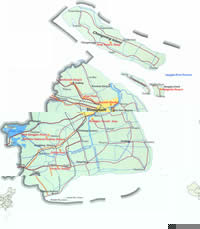
|
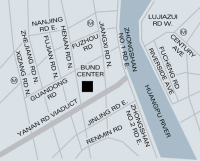
|
Click on the maps above for a more detailed view
Useful links
- Shanghai Weather
- Shanghai Maps
- Shanghai Travel
- Virtual Tourist
- Shanghai Tourist Attractions
- China National Tourist Office
Check back for further updates here: 


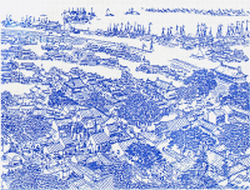
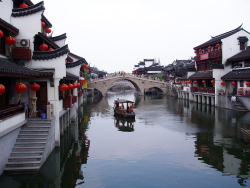
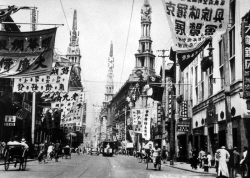
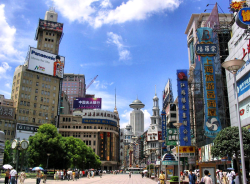
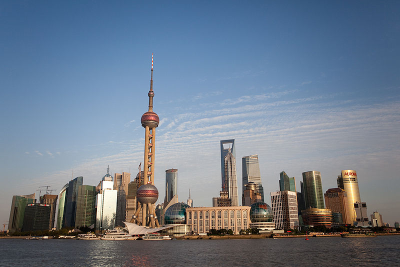

 Tel: +86.21.6335. 1888
Tel: +86.21.6335. 1888 Fax: +86.21.6335.2771
Fax: +86.21.6335.2771 Email:
Email: 